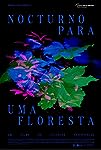Eye For Film >> Movies >> Nocturne For A Forest (2023) Film Review
Nocturne For A Forest
Reviewed by: Amber Wilkinson

“Fears know no walls.”
“No, fears are walls.”
This exchange is just one of the many paradoxical and complex ideas that are explored in Catarina Vasconcelos’ philosophical short film. She uses the Buçaco forest in Portugal as a jumping off point to consider the legacy of patriarchal societies, the contradictions of viewing history through a modern lens and the way we treat artworks in retrospect.
The forest was home to a Carmelite monastery, which the misogynistic Pope Gregory XV declared to be out of bounds for women, the plaque he sent “with his name on it” almost absurd in its baroque overstatement that: “Women are not allowed. Those that enter will be excommunicated. That is, they will go to hell and burn for all eternity.”
Vasconcelos then transports us to a lush forest where the film then unfolds in silent fashion, as the trees themselves - inhabited by the souls of dead women - are having an AGM, their conversation conveyed, as they glow in neon colours, by subtitles. The main subject of discussion is a painting by Josefa de Óbidos, La Sagrada Familia (The Holy Family). It is, of course, deeply ironic that this celebration of the maternal - showing Mary with milk spraying from her naked breast as she nurses the baby Jesus - would be hung in a place where no woman could ever see it.
The debate that unfolds considers “erasing” the artwork in the memory of the women who have gone before. There are extreme and moderate views here, which recall many a social media debate about everything from slavery street names to flags. Vasconcelos gives this a humorous touch but there’s a serious point to be made about the way we stitch the facts of the past into the fabric of our present. Beyond its thought-provoking subject matter, the film is well polished in terms of craft, from the still life framing of its early moments by Paulo Menezes to its futuristic scoring from the director herself which acts as a counterpoint to the classical music that is used elsewhere.
Reviewed on: 04 Aug 2023















